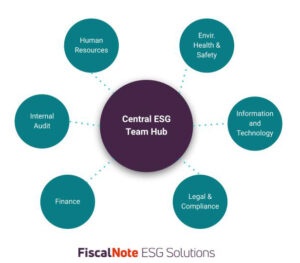The demand for ESG across corporations worldwide is palpable. Companies are clamoring to respond to the investor and regulatory pressure to improve disclosures and risk management around climate and other environmental, social, and governance-related issues.
If you’re the first person hired to pursue your company’s ESG agenda, one of your first duties will be to assemble a team. But in this nascent field, little guidance exists around who to hire, how to structure your team (both internally and within the broader organization), and what exactly makes a successful ESG team. In this article, we explore how the structure and composition of a team influence its performance.
1. Successful ESG Teams are Diverse and Cross-Functional
When we talk about diversity within ESG teams, we’re not just referring to diversity, equity, and inclusion (though that is important) — we’re talking about the way your team is structured.
The structure of an ESG team is fundamentally different from any other corporate team. While it’s important to hire a core group of dedicated ESG professionals, the key feature of a successful team in this space is how they bring in members from virtually every department within the organization.
Imagine your ESG team through the hub and spoke model: your core team forms the central hub, while key representatives or ambassadors from other departments act as the many spokes, liaising between their departments and your ESG team. The hub and spoke model is the most effective way to effect company-wide change and accountability.
 If diversity and cross-functionality define successful ESG teams, isolation defines the unsuccessful. Although ESG is its own discipline, it cannot be siloed into its own department. It sits across the rest of the firm’s departments, relying on these divisions for data and feedback, while having the authority to set targets and enforce accountability across the organization. In this sense, your ESG team becomes more like an organization-wide task force and less like a department with traditional boundaries.
If diversity and cross-functionality define successful ESG teams, isolation defines the unsuccessful. Although ESG is its own discipline, it cannot be siloed into its own department. It sits across the rest of the firm’s departments, relying on these divisions for data and feedback, while having the authority to set targets and enforce accountability across the organization. In this sense, your ESG team becomes more like an organization-wide task force and less like a department with traditional boundaries.
How to Select the Right People
Selecting members for your ESG team will come down to passion and enthusiasm over technical knowledge. Most of the team members you recruit from other departments won’t be deeply versed in ESG. That’s okay — they can learn on the job. What matters is that they have a good understanding of the operations of their own department and can collaborate effectively between their departments and the ESG team.
To find your representative from each division, work with department heads. They’ll know their team members better than anyone, and you’ll want their buy-in and approval. ESG responsibilities may become a key part of your ambassador’s work, so it’s important they have the flexibility and resources they need to dedicate themselves to their new ESG role.
Which Departments to Involve
At a minimum, include team members from accounting and financial reporting teams, supply chain and procurement, legal, and human resources. Beyond these key functions, the other departments you decide to include will be determined by materiality. While you want to avoid creating a team that is too large to be effective, the more departments you can get on board, the more effective your ESG initiatives will be and the easier it will be to collect data for reporting.
2. Successful ESG Teams are Lean at the Core
While the majority of your ESG team will comprise representatives from other departments, you’ll still need to retain a small core team of ESG-trained professionals. Your core team can be structured much like any corporate team: senior management at the top (chief sustainability officer, for example) who liaises with the board and other executives; managers in the middle (if necessary); and more junior team members at the base to help gather and manage data.
The number of people you’ll need in your core team depends on the size of the organization, the limitations of your budget, the scope of your reporting commitments, and the ambitiousness of your ESG targets. Regardless of headcount, keeping this central team as lean and agile as possible is essential for making fast progress on ESG initiatives. If isolation is the leading killer of ESG success, bureaucracy is a close second.
What to Look For
Most of your core team roles will be hired from outside the organization — you’re looking for people with in-depth ESG knowledge rather than departmental expertise. Unfortunately, the demand for ESG has led to what some are calling a war on talent, so it may be difficult to find the right people quickly. That’s why it’s important not to let the hiring of your core team delay engaging your distributed team; get started finding your ESG team members from various departments while you’re hiring your core team.
When reviewing applications and conducting interviews, look for training in ESG or sustainability-related matters. In the young field of ESG, having many years of experience is often less important than experience or training that is recent and relevant. Experience with ESG reporting frameworks and standards is particularly important, as well as up-to-date knowledge of policy and regulatory changes. Prior corporate experience is ideal, even if they did not gain this experience in an ESG role. It’s also important to look for someone highly skilled in data and data analysis and with strong communication and stakeholder engagement skills. Above all, look for enthusiasm — ESG requires a long-term focus, so look for people who genuinely care about organizational change.
Hire From the Other Side
One less common strategy is to seek out ESG professionals who have spent time on the other side — that is, ESG analysts or finance professionals with experience in analyzing disclosures for investment firms. This unique experience would give your team valuable insight into what your investors are looking for, what makes ESG disclosures decision-useful, and how to stand out in the noisy world of ESG reporting.
Focus on Retention
The demand for ESG disclosures and expertise has led to a war on talent largely responsible for the high turnover rates on ESG teams. Headhunting and job-hopping are common occurrences in this sought-after field, so expect your search for talent to be difficult, and take careful considerations once you’ve hired team members to ensure they remain engaged and fairly compensated. Key person dependence is inevitable in a developing field (although technology can help to reduce this dependence), so treat your people well.
3. Successful ESG Teams Receive Top-Down Support
We can’t talk about successful ESG initiatives without acknowledging the role of the board and C-suite executives. Your core ESG team reports directly to the board, which should act as the team’s chief supporter and advocate. Without vocal top-down support for ESG (backed by adequate resources), getting meaningful ESG initiatives off the ground will be difficult.
If you’ve been hired, then it’s probable your board or senior managers are already invested in ESG. But continually engaging with the board is a key responsibility of the ESG team, and it’s important that it has the skills to translate company ESG data into decision-useful insights that can be quickly understood and actioned by the board. When choosing talent for your core team, look for strong communicators, persuasive speakers, and professionals with experience in engaging key stakeholders.
4. Successful ESG Teams Have Authority
“What makes the central team particularly effective is having the decision-making authority to execute change,” reads a McKinsey article on effective sustainability teams. McKinsey breaks down this authority across multiple dimensions: the ability to engage the board on ESG topics, set centralized targets to keep other departments accountable and mobilize executives and leaders to define the company’s ESG vision at the corporate level.
A lack of agency leads to a reactive, rather than a proactive, ESG team. Though the team may be able to meet reporting requirements and disclosure demands without significant authority, a team with no sway over organizational change would be limited to only performing retroactive compliance tasks. Reporting is a key responsibility of the ESG team, but it is only one of many. It should be the starting point for organizational change and improvement on ESG-related metrics and risk management. Without the authority to advocate for change both vertically and horizontally, your ESG team is destined for a life of reporting on ESG inaction rather than working toward ESG reform.
5. Successful ESG Teams Have Resources
Corporate teams can’t be built out of thin air. To attract and retain the necessary talent, meet extensive reporting requirements, and equip the organization for a low-carbon, ESG-first future, your team needs the resources to make things happen.
You’ll need a clearly defined budget set directly by the board; one that accommodates the number of team members you’ll need, technology and tools to support your team, and other resources you may need come reporting time. The budget should leave room for investing in professional development — particularly for those team members joining the ESG working group from other departments. Unsure where to start? The average corporation spends $533,000 annually on ESG disclosures.
How FiscalNote ESG Can Help Build Your ESG Dream Team
Central to keeping core teams lean is supplementing your human workforce with the tools they need to improve the speed and efficiency of tasks such as benchmarking, data collection, and reporting preparation. Not all tasks and responsibilities require human team members; relying on software cuts down on the number of people you need on your team, freeing up more budget for proactive ESG initiatives.
The right software can help you keep abreast of ESG trends and insights, benchmark across your industry and supply chain, and manage all your ESG data in one place. Future-proof your organization’s ESG strategy with Equilibrium, a next-gen, end-to-end ESG management solution that helps companies move past static spreadsheets and legacy solutions.
Learn more about how FiscalNote ESG Solutions and Equilibrium can help you stay ahead of ESG disclosure, sustainability reporting, and climate risk management across your entire value chain.





